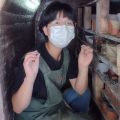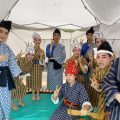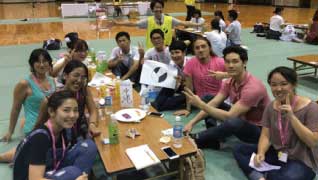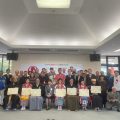[Interview] 2022 Kempi International student Gabriel Yuji Nakashima
1:00 PM
Okinawa Prefectural Government will select exemplary individuals from descendants of Okinawan emigrants and Asian countries (hereinafter referred to as “international students”). The international students shall receive education and training at universities, businesses, and institutions for learning traditional arts in Okinawa Prefecture (hereinafter referred to as “universities and other institutions”). Students will be provided with opportunities to understand Okinawan history, culture, and customs, gain work experience at local businesses, and promote exchange with local people. The aim of the program is to cultivate human resources capable of serving as a bridge between students’ home countries and Okinawa, foster the preservation of the Uchinā Network for the next generation and contribute to international exchange with Okinawa Prefecture.
We interviewed Gabriel Yuji Nakashima, a 2022 Kempi international student.
Please take a look at Yuji’s thoughts on Okinawa and studying abroad etc...
1. Home country
Brazil. I was born and raised in Curitiba, Paraná.
2. Occupation
I have a qualification in architecture and am also engaging in research in the field.
3. Ancestor's (Uyafaafuji's) birthplace
My father's family, with the surname Nakashima, originates from Saga Prefecture. On the other hand, my mother's family, who are Uchinanchu, are from Kuniyoshi and originally from Sokei, now Ginowan Village. Unfortunately, we don't have much contact with the Ginowan Sonjinkai, Association, but during The Worldwide Uchinanchu Festival, I had the opportunity to attend events in this area. While I was the only Brazilian there, I had an online call with members of the Ginowan Village Sonjinkai from various countries, including Brazil, and through this, I was able to meet people from Ginowan, especially those from Campinas in Brazil! By the way, I later found out that my grandfather had already visited the association before. It was a very joyful encounter!
4. What do you want to do or strive for during this study abroad?
Eleven years ago in 2011, I participated in the Junior Study Tour (now UJS: Uchina Junior Study) and came to Okinawa for the first time. It was a great experience, and I made many friends, but at the age of 17, during my short stay of about three weeks at a relative's house, I was too young to fully understand the cultural differences and learn from them. I don't think I was independent enough to pursue my interests while living in Okinawa. However, I believe this is one of the purposes of JST—to create the initial connection with our hometowns and share our identities with people around the world. Now, on my second visit to Japan, I have a clearer understanding of what I want to do. One of my goals is to learn Japanese. By improving my "Japanese," I want to be a bridge between Japan, Okinawa, and our descendants. That's why I'm studying at Okinawa International University in Ginowan City. I am also interested in Uchinaaguchi (Okinawan language), but since it's not widely used even in Okinawa, I haven't had the opportunity to delve into it. It's unfortunate considering it's a language registered on UNESCO's "List of Endangered Languages and Dialects" since 2009. Apart from Japanese classes, I attend Okinawan art classes and participate in various clubs. I've started joining a hiking class once a month and have also joined a Ryukyuan dance class. I wanted to confirm everything I've heard since I was a child at Kenjinkai—whether the Uchinaanchu indeed lead a more relaxed and gentle lifestyle than Japanese, whether they really eat bitter melon, goya champuru, naabera, and so on. I also wanted to check if Uchinaanchu words like "Haisai," "Choodii," and "Akisamiyo" are used. In any case, there were things I could confirm and things I couldn't. However, coming here, I needed to see, hear, and feel Okinawa's daily life with my own eyes and ears.
5. Favorite Okinawa word
As me raised with Ryukyukoku Matsuri Daico, my favorite word is "Heeyaasassā! Haaiiyā! Naatiichē! Haaiyā!" And as a "Gachimayā," the phrase "Kwācchī Sabira" is very useful! Hahaha
6. Have you ever participated in a Worldwide Uchinanchu Festival before?
In 2020, I applied for this scholarship, but due to the impact of the coronavirus, I had to reapply every year, and I waited for two and a half years until I could come to Okinawa. I arrived in Okinawa in mid-September this year and will be staying until mid-March 2023. I had never participated in The Worldwide Uchinanchu Festival before, and I didn't imagine I would be able to participate during this study abroad. It was worth the wait.
7. How do you feel about participating in this year's 7th U Congress?
Since it was my first time participating, I can't compare it to previous experiences, but it was truly enjoyable. From October to November, it was a very busy period. There were numerous events in Okinawa.
Just before the festival, from October 27th (Thu) to October 29th (Sat), the "World Youth Uchinanchu Festival" took place, and we also participated.
Sunday was a special day. October 30th was "World Uchinanchu Day."
We kicked off the celebration with a traditional parade along Kokusai Dori, marking the beginning of The Worldwide Uchinanchu Festival. Meeting friends and acquaintances, walking down the main street to the rhythm of samba, I felt enveloped in immense happiness, sensing the start of the event. It felt very Brazilian to me.
Unfortunately, on the next day, October 31st (Mon), an official opening ceremony for the public was canceled due to heavy rain and strong winds. A scaled-down event took place. I couldn't attend the ceremony, but gathering with fellow prefectural scholarship students at the Okinawa International Center (JICA Okinawa) to watch the live stream was a good alternative. Despite the unforeseen circumstances, it was incredibly enjoyable to celebrate alongside other Uchinaanchu.
On November 1st (Tue), there were meetings regarding "Uchinanchu Day." On November 2nd (Wed), there were events in each region where Uchinanchu and Shimanchu gathered from various towns and villages. These events took place according to the regions in Okinawa. On this day, I had the opportunity to learn more about my hometown, Ginoza Village, and could also meet with family members.
On November 3rd (Thu), the closing ceremony of the festival was held and was very lively. Despite the opening ceremony not meeting expectations and many overcast days, the weather was favorable this time. As the sky changed from blue to orange, we could enjoy the closing ceremony until it got dark. I saw the band "DIAMANTES" for the first time, got to know Okinawan rock through "MURASAKI," and sang along with "BEGIN," shedding tears. There were also performances by the Ryukyukoku Matsuri Daiko and traditional Eisa presentations by the Ryukyu Kajimaya (an Eisa group at Okinawa International University where I am studying).
Finally, we wrapped up the festival with the highlight, beautiful fireworks. Then, at night, we had a celebration at an Izakaya, cherishing our time together before parting ways.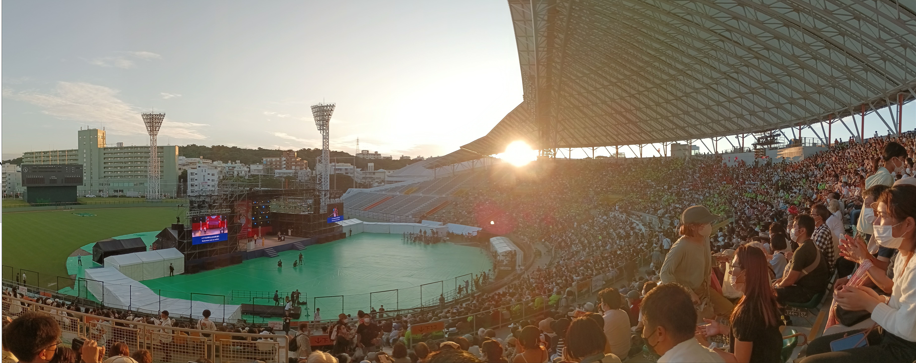
The Worldwide Uchinanchu Festival is indeed quite large in scale, and with multiple events happening simultaneously, it's challenging to participate in everything. There might be a need to come again on a different occasion! Hahaha. But I was very satisfied with my first festival. It was truly delightful to celebrate our roots and culture, especially in Okinawa, the land of our ancestors, alongside everyone who holds a fondness for Okinawa.
8. How do you like living in Okinawa?
It's nothing but wonderful, and there's no way to complain. My happiness lies in being in Okinawa, but being here as a prefectural scholarship student makes it even more joyful. Over the 2 and a half years amidst the COVID-19 pandemic, my desire to come here evolved from the initial application in early 2020. At the beginning of this year, I had planned to apply for this scholarship program, but I was hesitant about whether it was really the right time to come. Even though the ticket to study abroad was guaranteed by the Kenjinkai, after waiting for 2 and a half years, I also considered working instead of studying. However, I have no regrets about studying abroad this time. The prefectural scholarship program has been a fantastic experience. It allows you to travel, learn various things, and have new experiences. I have had two previous experiences with exchange programs. The first was in 2011 when I stayed in Okinawa for three weeks through the JST program. In 2015, through the MARCA program, I stayed for a semester as an architecture student in Sucre, Bolivia. Including this current scholarship study, these are unforgettable and amazing moments in my life.
In our daily life, initially, it felt great to go shopping at convenience stores, eat Japanese and Okinawan cuisine, ride the Yui Rail (Okinawa's monorail), and visit tourist spots. However, after a while, my soul started yearning for something more. For us who got the chance to return to our hometown through this study abroad, reuniting with family and reclaiming the time lost due to migration is the most important.
Eleven years ago, I stayed with distant relatives, the Yara couple. At that time, I brought back a Japanese book written by my grandfather, Shinichi Kuniyoshi. I had never looked at that book. Even though I lived with my grandfather for quite a long time, we hardly had conversations. My grandfather, who passed away two years ago, was a hardworking person. He often didn't understand Portuguese, and I couldn't ask many questions. I don't remember talking about my grandfather's other aspects of life, such as his time as an immigrant, experiences during the war, his life in Uchina or Ginoza, or what it was like before he went to Brazil or became Brazilian, despite living together for a considerable period.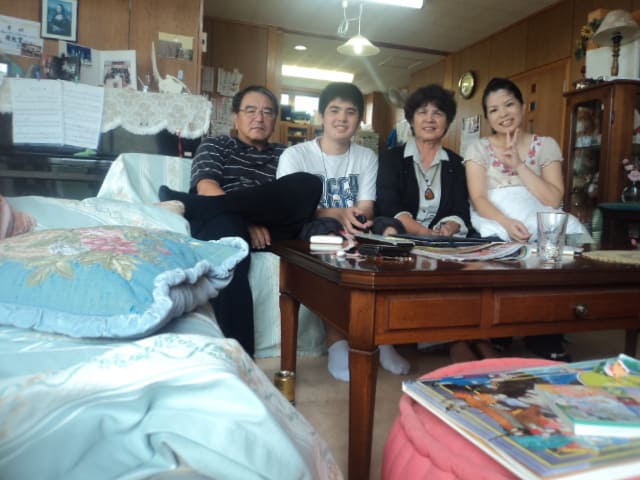
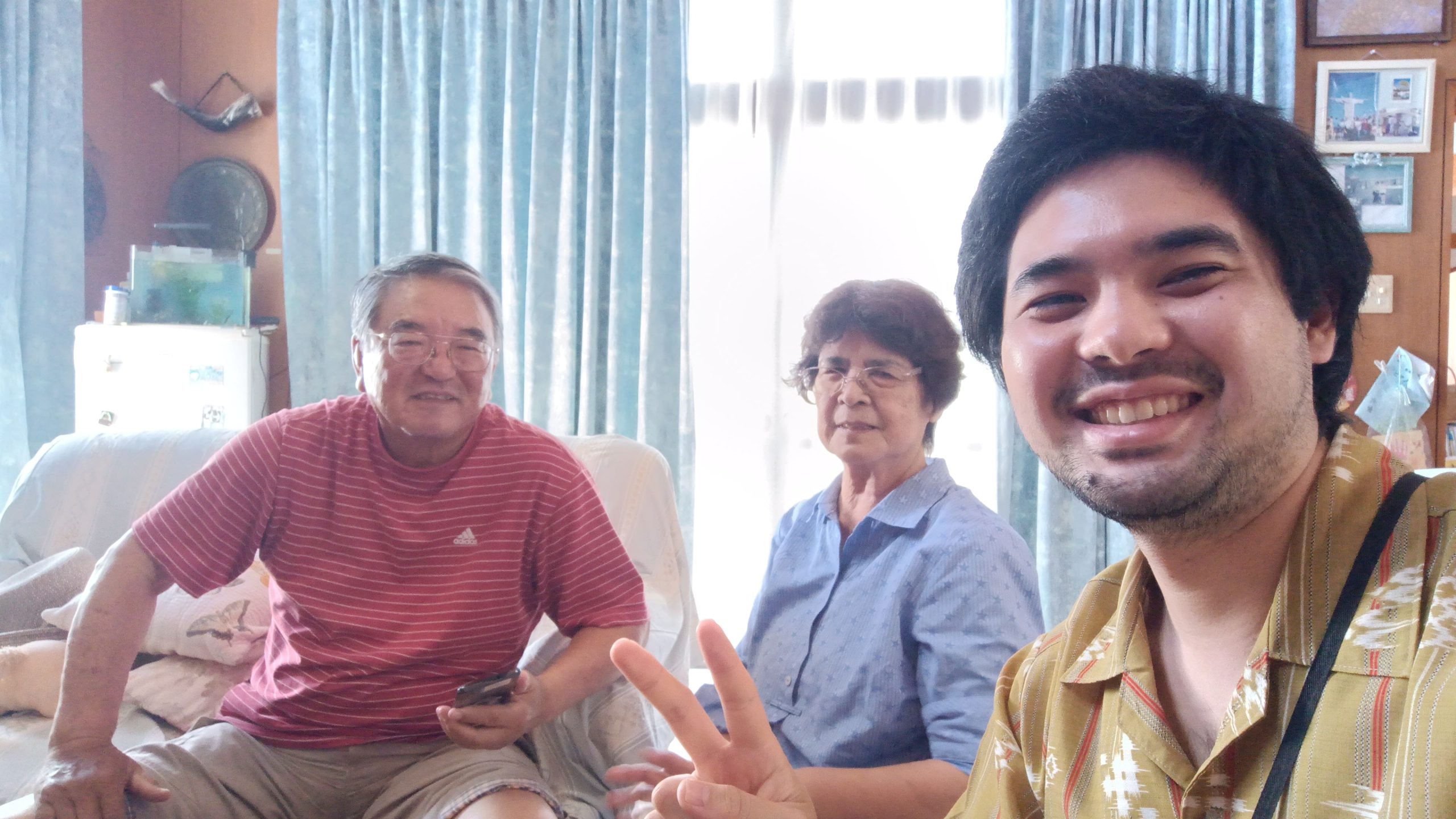
Currently, reading a part of this book, I have come to understand my family's history more deeply. My grandfather not only talks about war and migration but also discusses the complex relationship with my mother's great-grandmother, Katsu (referred to as Oba at home). Interestingly, he talks about Kanna, the actual home of his mother's family where they grew up together. For instance, my grandfather, being from a samurai lineage, didn't go to school to maintain his traditional hairstyle, "Kampuu," which was not to be cut for attending school.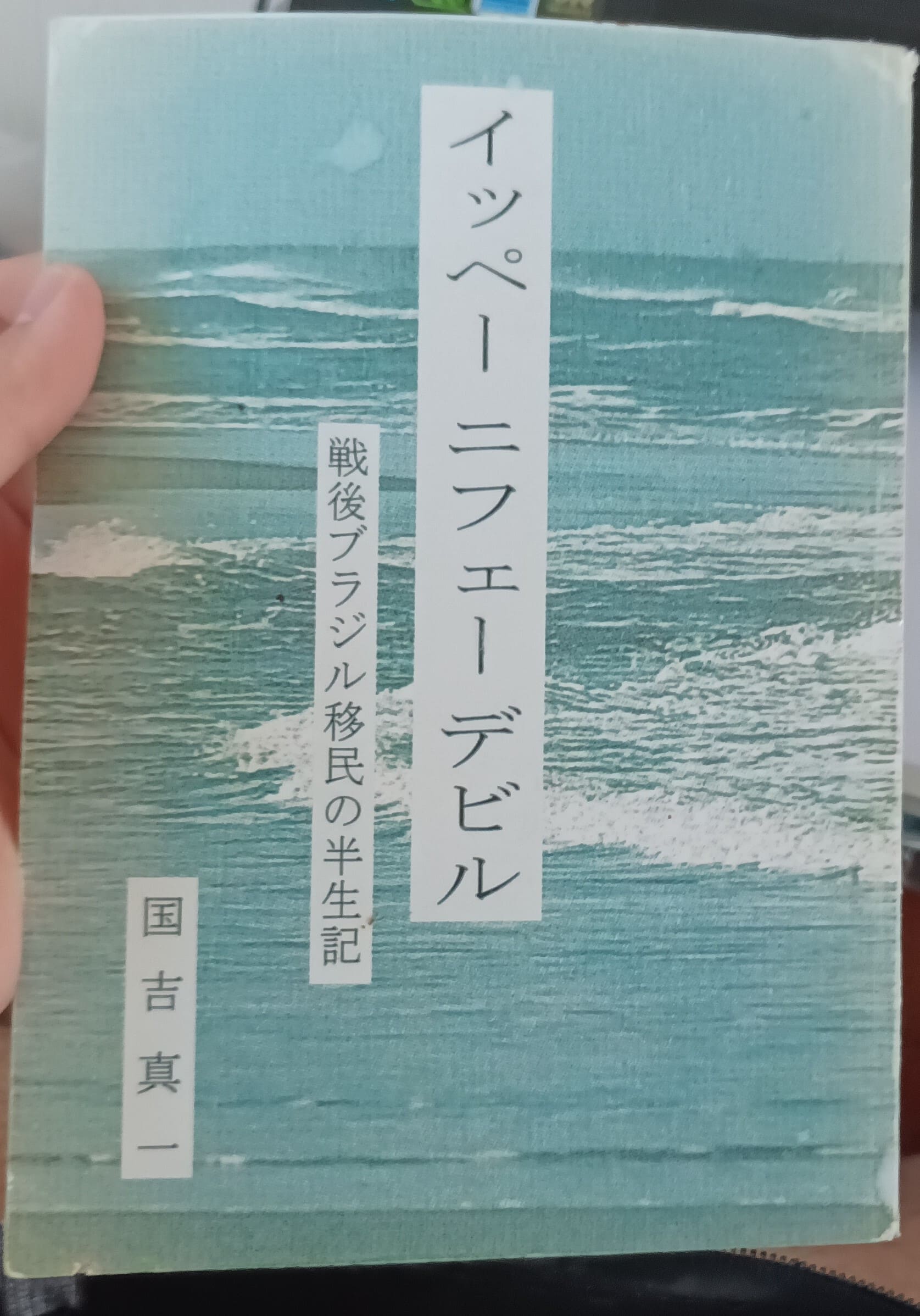
Thanks to this family history, I have been able to clarify who I am. Participating in this prefectural scholarship study abroad has enriched my knowledge beyond the experience of studying abroad itself. I am grateful to have been able to rescue a part of the Kuniyoshi and Kanna family history.
9. What you can do and what you will do to connect the Uchina network after you return home?
I intend to encourage the people of Curitiba to know their own history. As descendants of immigrants who crossed the earth, I believe it's crucial to understand one's family history as much as possible. Since the Okinawan community in Curitiba is relatively small, such initiatives are rare.
Hence, valuing the connection with the past has become challenging. Life is complex, and often there isn't enough time for reflection. In the quest to find our origins, we need not only determination but also a lot of encouragement and favorable circumstances.
Moreover, sharing the experiences gained through interactions with other Uchinanchu, I, who grew up near the Okinawa Kenjinkai and the Ryukyukoku Matsuri Daiko Curitiba branch, realized that within our Okinawan community, each group and its daily life, customs, events, and their respective "Okinawa" essentially create our own world. Without this realization, stories and legends passed down through generations, which have been inherited without interaction with the outside groups, without knowing the Okinawa of our ancestors, continue to be passed on. Therefore, I hope more people come to understand the "Bankoku Shinryo"(A bridge connecting the world) and "Chanpuru Culture" from the Ryukyu Kingdom Story that we talk about.
10. Similarities between my home country and Okinawa that you did not know before
It's a tough question, haha. I had to think about it. In the end, we tend to focus on the differences, but there are similarities too. It's a simple observation, but I noticed something in front of the university. In Curitiba, you often see people selling food at the entrances of universities and vocational schools, usually hot dogs or popcorn stands. Here at Okinawa International University too, you don't see people eating on the streets, but during lunchtime, there are always food stalls selling Bento both outside and inside the university. By the way, it's really delicious!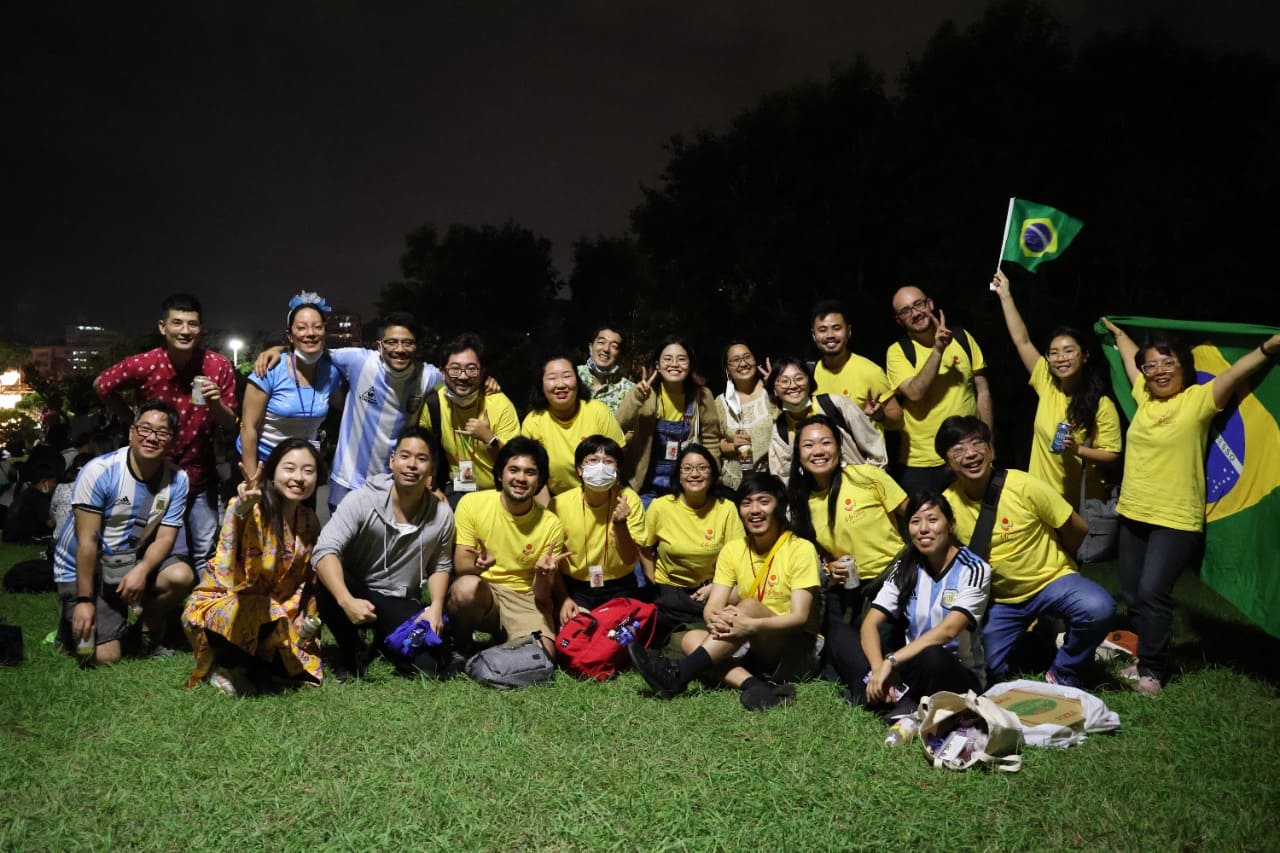
Moreover, there are similarities with the Brazilian-Okinawan and Okinawan communities. For example, at festivals, the arrangement of tents, seating areas for eating, stages, and more resemble those in Curitiba's festivals, but the food and products are slightly different. Additionally, the attire and seating manners of the uncles and aunties remind me of the Okinawan community in Curitiba. Also, the practice of everyone helping with party preparations and cleanup is a good habit.
11. What surprised you when you came to Okinawa
What surprised me was something I realized while talking to people in Okinawa. I have heard several times that Okinawa is a "car society," which is due to the need to use a car to get to many places. As students, we often use buses and the monorail, so we can feel this. Public transportation operates on a distance-based fare, and some routes run according to a timetable, so it's essential to always check the schedule. Malls often have three-story parking lots and two-story shops. Near Okinawa International University, there is a large parking lot on campus, and there are several small parking lots scattered nearby. However, the transportation system functions very well. Buses may sometimes be delayed, but the system is good. You insert coins into a counting machine to pay, the driver waits calmly for everyone to be seated before departing, and there is air conditioning inside the bus.
Another thing that surprised me is that Okinawan words and surnames are used in the names of restaurants, shops, and public spaces around the city. There's an izakaya near my house called "ぐすくー台所" ("Gusukū Daidokoro"), but I haven't eaten there yet, so I'd like to go and try it.
In Ginowan City, there is a very beautiful park called "Kakazu Takadai.” I visited this park during a class with "Smilife from Okikoku," a student group that volunteers as guides in Okinawa to raise awareness for peace. During the visit, we were explained that the Kakazu area and the hill where the park is located were fierce battlefields. I remember being told that while approximately 1 in 4 people in the entire Okinawa suffered casualties during the war, in Kakazu, it was about 1 in 2.
Anyway, there are many places with familiar names and words here. While Uchinaguchi is becoming less used, it's heartwarming to see these names etched in many spaces.





